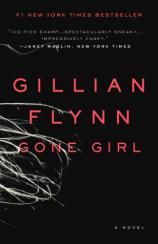Author Essay: July 6, 2012
I was not a nice little girl. My favorite summertime hobby was stunning ants and feeding them to spiders. My preferred indoor diversion was a game called Mean Aunt Rosie, in which I pretended to be a witchy caregiver and my cousins tried to escape me. Our most basic prop was one of those pink, plastic toy phones most little girls owned in the ’80s. (Pretty girls love to talk on the phone!) Alas, it was always snatched from their fingers before they could call for help. (Mwahaha) In downtime, I also enjoyed watching soft-core porn on scrambled cable channels. (Boob, bottom, static, static, boob!) And if one of my dolls started getting an attitude, I’d cut off her hair.
My point is not that I was an odd kid (although looking at this on paper now, I worry). Or that I was a bad kid (here’s where I tell you --- for the sake of my loving parents --- that I had enjoyed happy wonder years back in good old Kansas City). But these childhood rites of passage --- the rough-housing, the precocious sexuality, the first bloom of power plays --- really don’t make it into the oral history of most women. Men speak fondly of those strange bursts of childhood aggression, their disastrous immature sexuality. They have a vocabulary for sex and violence that women just don’t. Even as adults. I don’t recall any women talking with real pleasure about masturbating or orgasms until Sex and the City offered its clever, cutie-pie spin, presenting the phrases to us in a preapproved package with a polka-dot bow.
And we still don’t discuss our own violence. We devour the news about Susan Smith or Andrea Yates --- women who drowned their children --- but we demand these stories be rendered palatable. We want somber asides on postpartum depression or a story about the Man Who Made Her Do It. But there’s an ignored resonance. I think women like to read about murderous mothers and lost little girls because it’s our only mainstream outlet to even begin discussing female violence on a personal level. Female violence is a specific brand of ferocity. It’s invasive. A girlfight is all teeth and hair, spit and nails --- a much more fearsome thing to watch than two dudes clobbering each other. And the mental violence is positively gory. Women entwine. Some of the most disturbing, sick relationships I’ve witnessed are between longtime friends, and especially mothers and daughters. Innuendo, backspin, false encouragement, punishing withdrawal, sexual jealousy, garden-variety jealousy --- watching women go to work on one another is a horrific bit of pageantry that can stretch on for years.
Libraries are filled with stories on generations of brutal men, trapped in a cycle of aggression. I wanted to write about the violence of women.
So I did. I wrote a dark, dark book, my first: SHARP OBJECTS. It’s a novel with a narrator who drinks too much, screws too much, and has a long history of slicing words into herself. With a mother who’s the definition of toxic, and a thirteen-year-old half-sister with a finely honed bartering system for drugs, sex, control. In a small, disturbed town, in which two little girls are murdered. There are no good women in SHARP OBJECTS. Camille, my narrator of whom I’m obsessively fond --- she’s witty, self-aware, and buoyant --- is the closest to “good.” And she uses booze, sex, and scissors to get through the day.
So SHARP OBJECTS is not a particularly flattering portrait of women, which is fine by me. Isn’t it time to acknowledge the ugly side? I’ve grown quite weary of the spunky heroines, brave rape victims, soul-searching fashionistas that stock so many books. I particularly mourn the lack of female villains --- good, potent female villains. Not ill-tempered women who scheme about landing good men and better shoes (as if we had nothing more interesting to war over), not chilly WASP mothers (emotionally distant isn’t necessarily evil), not soapy vixens (merely bitchy doesn’t qualify either). I’m talking violent, wicked women. Scary women. Don’t tell me you don’t know some. The point is, women have spent so many years girl-powering ourselves --- to the point of almost parodic encouragement --- we’ve left no room to acknowledge our dark side. Dark sides are important. They should be nurtured like nasty black orchids. So SHARP OBJECTS was my creepy little bouquet.
I wasn’t through with wicked women --- a discovery made as I wrote my second book, DARK PLACES. I swear I gave sweetness a shot: In early drafts, the narrator, Libby Day, was optimistic, proactive, and relatively healthy in the head. I hated her. For one thing, her uprightness felt wrong. At age seven, Libby became the lone survivor of an infamous 1985 murder rampage --- “The Satan Sacrifice of Kinnakee Kansas.” She was a scared kid who sneaked out a window as her family was being massacred...and later swore it was her teenage brother wielding the ax. Nearly twenty-five years later, would she really be so stable, so reasonable? I wouldn’t be. I’d be pissed. Self-pitying, defensive and really, really pissed.
Libby soon became the woman she was meant to be: one hell of an antihero. She can’t hold down a job. She manipulates and lies. She’s an opportunist and a raging kleptomaniac, particularly of other people’s cherished objects. She’s a scrapper, a fist-fighter, a serious bastard. “I have a meanness inside me, real as an organ,” she says. “Draw a picture of my soul and it’d be a scribble with fangs.”
People usually describe Libby as unlikable --- as if that were such a bad thing! To me she’s utterly likable in her dislikability. She’s a bitter, angry broad born without a single sweet bone in her body. Her occasional, wavering baby-steps toward decency should be respected, because they don’t come naturally. I think the messy, exhausting attempt to be good is worlds more interesting than goodness itself. Again, it’s a quest women rarely undertake in fiction. Men, the lame cliché goes, are natural dogs: To choose to be virtuous is a heroic act for them, and many a novel has been constructed proudly around this epic male journey. Women are assumed to be naturally good, and where does that leave us? As helpmates. Yay. I simply don’t want to read another book where a woman’s only challenge is to tame her man and lead him to decency. So I created --- and loved creating --- my feral girl-woman, my rotten little thing, Libby Day. Just try and reform her.
When I’m writing, I find my eyes often move to an old photo by Frederick Sommer I keep in my home. It’s called Livia --- the name, not coincidentally, of the murderous Roman empress. It’s a black-and-white shot of a young girl with all the accoutrements of innocence: Blond braids, lace-edged dress. But her eyes are startlingly intelligent, her lips stubborn, her whole face mischievous—perhaps malevolent. It’s one of my favorite photos in the world, a reminder that girls --- and women --- can be bad.




